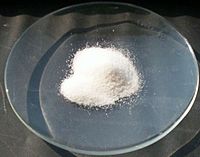Arsenic trioxide
 |
|
 |
|
| Names | |
|---|---|
|
Systematic IUPAC name
Diarsenic trioxide
|
|
| Other names
Arsenic(III) oxide,
Arsenic sesquioxide, Arseneous oxide, Ratsbane, Arseneous anhydride, White arsenic |
|
| Identifiers | |
|
1327-53-3 |
|
| 3D model (Jmol) | Interactive image |
| ChEMBL |
ChEMBL1200978 |
| ChemSpider |
452539 |
| DrugBank |
DB01169 |
| ECHA InfoCard | 100.014.075 |
| EC Number | 215-481-4 |
| KEGG |
C13619 |
| PubChem | 261004 |
| RTECS number | CG3325000 |
| UNII |
S7V92P67HO |
|
|
|
|
| Properties | |
| As 2O 3 |
|
| Molar mass | 197.841 g/mol |
| Appearance | White solid |
| Density | 3.74 g/cm3 |
| Melting point | 312.2 °C (594.0 °F; 585.3 K) |
| Boiling point | 465 °C (869 °F; 738 K) |
| 20 g/L (25 °C) see text |
|
| Solubility | soluble in dilute acids and alkalies, practically insoluble in organic solvents |
| Acidity (pKa) | 9.2 |
| Structure | |
|
cubic (α)<180 °C monoclinic (β) >180 °C |
|
| See text | |
| Zero | |
| Thermochemistry | |
|
Std molar
entropy (S |
? J.K−1.mol−1 |
|
Std enthalpy of
formation (ΔfH |
−657.4 kJ/mol |
| Pharmacology | |
| L01XX27 (WHO) | |
| Pharmacokinetics: | |
| 75% bound | |
| Hazards | |
| Safety data sheet |
See: data page |
| R-phrases |
R45, R28, R34, R50/53 |
| S-phrases |
S53, S45, S60, S61 |
| NFPA 704 | |
| Lethal dose or concentration (LD, LC): | |
|
LD50 (median dose)
|
14.6 mg/kg (rat, oral) |
| US health exposure limits (NIOSH): | |
|
PEL (Permissible)
|
[1910.1018] TWA 0.010 mg/m3 |
|
REL (Recommended)
|
Ca C 0.002 mg/m3 [15-minute] |
|
IDLH (Immediate danger)
|
Ca [5 mg/m3 (as As)] |
| Related compounds | |
|
Other anions
|
Arsenic trisulfide |
|
Other cations
|
Phosphorus trioxide Antimony trioxide |
|
Related compounds
|
Arsenic pentoxide Arsenous acid |
| Supplementary data page | |
|
Refractive index (n), Dielectric constant (εr), etc. |
|
|
Thermodynamic
data |
Phase behaviour solid–liquid–gas |
| UV, IR, NMR, MS | |
|
Except where otherwise noted, data are given for materials in their standard state (at 25 °C [77 °F], 100 kPa).
|
|
|
|
|
| Infobox references | |
Arsenic trioxide is an inorganic compound with the formula As
2O
3. This commercially important oxide of arsenic is the main precursor to other arsenic compounds, including organoarsenic compounds. Approximately 50,000 tonnes are produced annually. Many applications are controversial given the high toxicity of arsenic compounds.
Arsenic trioxide can be generated via routine processing of arsenic compounds including the oxidation (combustion) of arsenic and arsenic-containing minerals in air. Illustrative is the roasting of orpiment, a typical arsenic sulfide ore.
Most arsenic oxide is, however, obtained as a volatile by-product of the processing of other ores. For example, arsenopyrite, a common impurity in gold- and copper-containing ores, liberates arsenic trioxide upon heating in air. The processing of such minerals has led to numerous cases of poisonings. Only in China are arsenic ores intentionally mined.
In the laboratory, it is prepared by hydrolysis of arsenic trichloride:
As
2O
3 occurs naturally as two minerals, arsenolite (cubic) and claudetite (monoclinic). Both are relatively rare secondary minerals found in oxidation zones of As-rich ore deposits. Sheets of As2O3 stand for part of structures of the recently discovered minerals lucabindiite, (K,NH4)As4O6(Cl,Br), and its sodium-analogue torrecillasite.
...
Wikipedia

